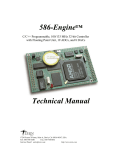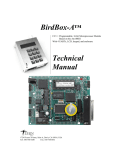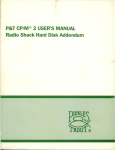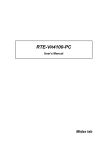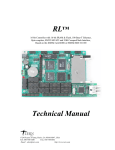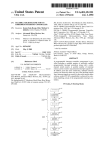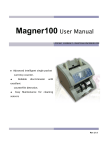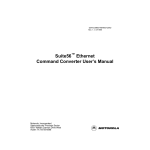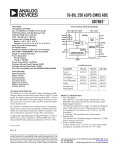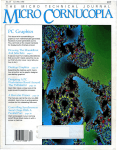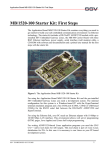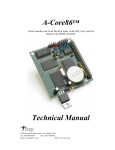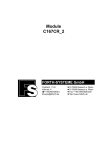Download 586-Drive™ Technical Manual
Transcript
586-Drive™ C/C++ Programmable, 133 MHz 32-bit Web Controller with Floating Point Unit, CompactFlash, 100M Ethernet, High voltage I/Os, and 24-bit ADC / DACs Technical Manual 1724 Picasso Avenue, Davis, CA 95618-0547, USA Tel: 530-758-0180 Fax: 530-758-0181 Email: [email protected] http://www.tern.com COPYRIGHT 586-Drive, 586-Engine, 586-Engine-P, NT-Kit, and ACTF are trademarks of TERN, Inc. Am188ES and Am186ES, ElanSC520 are trademarks of Advanced Micro Devices, Inc. Paradigm C/C++ is a trademark of Paradigm Systems. Windows95/98/2000/NT/ME/XP are trademarks of Microsoft Corporation. Version 1.1 January 24, 2007 No part of this document may be copied or reproduced in any form or by any means without the prior written consent of TERN, Inc. © 1993-2006 1724 Picasso Avenue, Davis, CA 95618, USA Tel: 530-758-0180 Fax: 530-758-0181 Email: [email protected] http://www.tern.com Important Notice TERN is developing complex, high technology integration systems. These systems are integrated with software and hardware that are not 100% defect free. TERN products are not designed, intended, authorized, or warranted to be suitable for use in life-support applications, devices, or systems, or in other critical applications. TERN and the Buyer agree that TERN will not be liable for incidental or consequential damages arising from the use of TERN products. It is the Buyer's responsibility to protect life and property against incidental failure. TERN reserves the right to make changes and improvements to its products without providing notice. 586-Drive Chapter 1: Introduction --------------------------------------------------------------------------------------------------------------- Chapter 1: Introduction INTRODUCTION The 586-Drive™ (5D) is a C/C++ programmable controller based on the 32-bit 133 MHz AMD Elan SC520. It combines this high performance 586 generation processor with an extensive set of industrial I/O features on a single-board. The SC520 integrates an Am586 CPU and a high performance ANSI/IEEE 754 compliant hardware floating point unit (FPU). The SC520 has a total of seven timers including PIT timers and GP timers, plus a software timer. A real-time clock (RTC) provides a time-of-day calendar and 114 bytes of battery backed RAM. 13 user programmable multifunctional I/O lines are available. One synchronous serial interface (SSI) supports full-duplex, high speed bi-directional communication. By default, 256KW low power 55 ns SRAM is installed to allow longer battery backup lifetime; this requires slower 2 wait state access to memory. Optionally, if battery backup is not required, a high speed 20 ns SRAM can be installed to allow higher performance zero wait state operation. In additional to the on-board surface mount Flash, a 32-pin DIP IC socket allows using traditional user application plug-in ROM/Flash. A 50-pin CompactFlash interface supports low cost, removable, up to 2 GB mass storage CompactFlash cards with Windows compatible FAT file system support. The 5D can be powered by a single unregulated DC power from 8V to 30V range with the on-board high-efficiency 5V switching regulator. NETWORKING/CONNECTIVITY An Fast Ethernet Module can be installed to provide 100M BaseT network connectivity. The hardware LSI TCP/IP stack implements TCP/IP, UDP, ICMP and ARP in hardware. With 16KB internal transmit and receiving buffer, the Ethernet module releases internet connectivity and protocol processing from the host processor. The system can easily handle TCP/IP traffic of up to 200 Kbyte/s. Samples for HTTP, Telnet, FTP applications are available. Up to 4 RS232 serial ports (2 from SC520, and 2 SCC2691) are available. Two ports can be factory-configured as RS485. INDUSTRIAL I/O By default, 7 high voltage inputs(30V), and 14 high voltage sinking drivers(ULN2003A) are installed in DIP sockets. Each driver is capable of sinking 350 mA at 50V per line. They can directly drive solenoids, relays, or lights. Optionally, 12 DAC channels can be installed in their place. Four high isolation voltage photo couplers (PS2701, NEC) can be installed to provide optically isolated inputs. Also, 16 additional input channels are provided with a 24-bit ADC(LTC2448), connected via hardware configurable buffer resistors and screw terminal blocks. Variable resistor dividers can be installed to allow variable(up to 30V) input range(as default, 0-5V). They can be processed as analog or digital signals. With a peak sample rate of 5 KHz, this ADC works well directly with analog signals from strain gages, current shunts, RTDs, resistive sensors, and also work well directly with thermocouples in the differential mode. A precision reference(LT1019/REF02) with a internal temperature sensor providing local temperature for thermocouple applications. In addition, a 4 ch. 16-bit parallel ADC (AD7655, 0-5V) supports ultra high-speed (1 MHz conversion rate) analog signal acquisition. The AD7655 contains two low noise, high bandwidth track-and-hold amplifiers that allow simultaneous sampling on two channels. Eight 16-bit digital to analog converters (TLC2600) can be installed to provide analog voltage (0-5V) outputs. With the 388 pin BGA package of the SC520, repair support is not available. The 5D works with TERN expansion boards including the UR8, C24, P100, and P300. Special Note: The core of the Am520 CPU operates at +2.5V and the I/O operation at +3.3V. Also, the input for the I/O is +5V compatable. Stresses above these can cause permanent damage to the SC520 CPU. Operation above these values is not recommended, and can effect device reliability. 1-1 Chapter 1: Introduction 586-Drive ------------------------------------------------------------------------------------------------------------- Features Features: • 151x82 mm. DIN rail mounting, 110 mA at 24V DC power • 133 MHz, AMD SC520, program in C/C++ • High performance hardware floating point coprocessor • Non volatile SRAM, Flash, RTC, timers, interrupts • 4 RS232/485 Async serial ports and 1 Sync serial port • CompactFlash and FAT16 file system support • 4 ch 16-bit ADC (AD7655) and 8 16-bit DAC(LT2600) • Hardware TCP/IP stack for 100M Base-T Ethernet • 16 analog or digital inputs(30V) with 24-bit ADC(LT2448) • 20+ Solenoid Drivers, 4 Opto-couplers, 10+ digital I/Os. Physical Description The physical layout of the 586-Drive is shown below. 7 HV Inputs 14 Solenoid Drivers Power Input: GND +12V H3: SER1 H5: SCB H4: SCA H2: SER0 Debug Port 16 Analog/Digital Inputs based on 24-bit ADC LTC2448 1-2 8 Analog Outputs TLC2600 4 Inputs 16-bit ADC AD7655, 1MHz 4 OPTOs 100M Ethernet 586-Drive Chapter 1: Introduction --------------------------------------------------------------------------------------------------------------Expansions of the 586-Drive: A P300 expansion board can be driven by the 586-Drive. A low power graphic 192x128 pixel LCD can be driven by the 586-Drive. 1-3 Chapter 1: Introduction 586-Drive ------------------------------------------------------------------------------------------------------------- Power On or Reset Step 2 jumper set? YES Validation of battery back up? NO STEP 1 ACTF menu sent out through ser0 at 19200 baud NO Set the CS:IP in internal RAM to 8000:0000 YES STEP 2 Go to application code CS:IP in CPU's internal RAM Figure 1.1 Flow chart for ACTF operation The “ACTF boot loader” resides in the 256KW on-board Flash chip (29F400). At power-on or RESET, the “ACTF” will check the STEP 2 jumper. If STEP 2 jumper is not installed, the ACTF menu will be sent out from serial port0 at 19200 baud. If STEP 2 jumper is installed, the 586Drive will check for a valid battery back-up. If present, it will go to the jump address stored in the CPU’s 114 bytes of general purpose RAM. Without a valid battery back up, it will write the address 0x80000 to the inernal RAM, and then go to that address. There is a 32-pin ROM socket on the 5D. The user’s application program must reside in SRAM for debugging in STEP1, reside in battery-backed SRAM for the standalone field test in STEP2, and finally be programmed into Flash for a complete product. For production, the user must produce an ACTF-downloadable HEX file for the application, based on the DV-P. The “STEP2” jumper (J2 pins 38-40) must be installed for every productionversion board. Step 1 settings In order to correctly download a program in STEP1 with Paradigm C++ Debugger, the 5D must meet these requirements: 1) 5860_115.HEX must be pre-loaded into Flash starting address 0x80000. 2) The CPU’s 114 bytes of RAM must have the correct jump address pointing at 5860_115.HEX, which is the address 0x80000. 4) The STEP2 jumper must be installed on J2 pins 38-40. For further information on programming the 586-Drive, refer to the Software chapter. 1-4 586-Drive Chapter 1: Introduction --------------------------------------------------------------------------------------------------------------- 1.2 586-Drive Programming Overview Steps for 5D based product development: Preparation for debugging (By default, this is done in the factory !): • Connect board to PC via serial link at 19,200, N, 8, 1 with Hyper Terminal • Power-on without STEP 2 Jumper installed (J2.38 = J2.40) • ACTF Menu will be sent from SER0 to external HyperTerminal at 19,200 baud • Type ‘D’, then <enter> to download. Send Text File \tern\586\rom\l_29f400.hex • Type ‘G04000’, then <enter> to execute HEX file just sent; will prepare flash • Send Text File \tern\586\rom\5860_115.hex • Type ‘G80000’, then <enter> to execute debug kernel • Set STEP 2 Jumper (J2.38 = J2.40) • Power-on/reset, ready to connect to Paradigm C/C++ for debugging STEP 1: Debugging • Launch Paradigm C/C++. Open \tern\586\samples\5d\5d.ide. • Run sample code • Create application using sample code. • Use Paradigm C/C++ to edit, compile, link, locate, and remote debug STEP 2: Standalone field test • Downloaded code from STEP 1 is located by default at 0x0800:0x0000 in the battery-backed SRAM • Set Jump Address to point to downloaded code. Remove STEP 2 Jumper and cycle power. Setup Hyper Terminal and see ACTF menu sent from 5D. • Type ‘G08000’, then <enter> to jump to and execute application in SRAM • Set STEP 2 jumper. 5D will execute application at 0x08000 at power-up. • Test application. Return to STEP 1 as needed STEP 3: Production (DV-P Kit required) • Use Paradigm C/C++ to generate ACTF downloadable application HEX file. • In Paradigm C/C++, open Target Expert for application. Set “Target Connection” to “No Target/ROM”. Build target. Paradigm C/C++ will generate HEX file. • Remove STEP 2 Jumper and see ACTF menu at hyper terminal. Download “l_29f400.hex”. Same process as above. Type ‘G04000” to prepare flash • Send you application HEX file. Type ‘G80000’ to execute code and set jump address to point to you application in flash. • Set STEP2 Jumper 1-5 586-Drive Chapter 2: Installation ----------------------------------------------------------------------------------------- Chapter 2: Installation 2.1 Software Installation Refer to the Technical manual “Software_Kit.pdf” on TERN CD under tern_docs\manuals. By manufacture default upon shipment, the 586-Drive should be ready to communicate with Paradigm C++ for debugging, with STEP2 jumper installed, CMOS RAM setup for 0x80000, and 5860_115 debug kernel residing in Flash starting 0x80000. Power on, the on-board LED should blink twice indicating running debug kernel. You DO NOT have to download debug kernel into flash again. You can SKIP the operation discussed in 2.2 below. 2.2 Prepare 586-Drive for Paradigm C++ TERN Edition This section uses RTLOAD to communicate with the ACTF utility while chapter refers to a hyper terminal. Either works fine. 1) Start Paradigm C++. Select from Top menu: Tool, RTLOAD, A HEX file Loader window will be shown. 2-1 586-Drive Chapter 2: Installation ----------------------------------------------------------------------------------------- 2) F5=Select Baud, to setup 19200. 3) F8=Select .HEX file from c:\tern\586\rom\L_29F400.HEX 3) Power on the 586-Drive with the STEP2 jumper off, the ACTF menu will show up. 2-2 586-Drive Chapter 2: Installation ----------------------------------------------------------------------------------------- 4) Caps Lock on your PC keyboard, Type “D” command, then enter. 5) F6 = Upload .HEX file, from PC to 586 SRAM. 2-3 586-Drive Chapter 2: Installation ----------------------------------------------------------------------------------------- 6) Type “G04000” to run the “L_29F400” in SRAM. The first time you type “G04000” you will get an error. Doing the “G04000” again, you will see as below The 29F400 Flash sector 0x80000 to 0xFBFFF will be erased. It will then be ready to program Flash with new DEBUG kernel file (c:\tern\586\rom\5860_115.hex), or user application .HEX. 7) F8= Select .HEX file, from c:\tern\586\rom\5860_115.hex. 2-4 586-Drive Chapter 2: Installation ----------------------------------------------------------------------------------------- 8) F6=Upload .HEX file to program the 5860_115 debug kernel into Flash starting address 0x80000. After programming the Flash, 586-Drive will automatically reset. “G80000” to setup the CMOS RAM Jump Address, and start the DEBUG kernel. The on-board LED should blink twice and then stay on; indicating 586-Drive is ready for remote debugging. Power off the controller. Install the STEP2 Jumper, then power on, the LED blink twice. Use F9 = Exit. The 586-Drive is ready for using Paradigm C++ TERN Edition to download, debug, and run. There are several sample projects in the c:\tern\586 directory (default working directory): 2-5 586-Drive Chapter 2: Installation ----------------------------------------------------------------------------------------tern\586\led.ide: The most basic sample project, just flashes LED tern\586\test.ide: Gives samples for serial ports, interrupts, timers. etc tern\586\samples\5d\5d.ide: Shows how to use hardware components on board. To open projects, go to “File” and open the sample project file, then build and download. There are many sample programs under c:\tern\586\samples. After you debug your application code, you can setup the 586-Drive to run in Standalone Mode. Standalone Mode(STEP2): By default, the Paradigm C++ TERN Edition will download your application code starting at 0x08000 in the battery backed SRAM. Power off 586-Drive. Remove STEP2 jumper. On PC side, click TOOL, RTLOAD. Power on 586-Drive again without STEP2 jumper, then the ACTF menu should show up. At the ACTF menu prompt, type “G08000” to setup the Jump Address and run your application. Power off, install the STEP2 Jumper. Then at power on, controller will jump to 0x08000 in SRAM and run your application. 2-6 586-Drive Chapter 2: Installation ----------------------------------------------------------------------------------------- 2.3 Hardware Installation Overview • Connect debug serial cable: For debugging (STEP 1), place IDE connector on SER0 (H2) with red edge of cable at pin 1 • Connect wall transformer: Connect 9V wall transformer to power and plug into power jack adapter which installs in 2-pin screw terminal Power Jack STEP2 red jumper Debug serial cable installed on SER0 (H2) with red edge of cable aligned with pin 1. Other end to PC’s COMx port. Watchdog Jumper 2-7 586-Drive™ Chapter 3: Hardware Chapter 3: Hardware 3.1 SC520 - Introduction The 586-Drive is based on AMD Elan SC520 Microcontroller. It includes an industry-standard Am5x86 CPU with floating point unit (FPU). It provides a General-Purpose (GP) bus with programmable timing for 8 and 16-bit devices. A ROM/Flash controller supports on-board high performance code execution. An enhanced programmable interrupt controller (PIC) prioritizes 22 interrupt levels with up to 15 external sources. Two asynchronous UARTs can operate up to 1.15 M bit/s. A Synchronous Serial Interface (SSI) offers full-duplex or half-duplex operation to support on-board ADC/DACs and user expansion. A real time clock, a software timer, 3 GP timers, and 3 programmable interval timers are all included. Thirty-two programmable I/O pins are on-board. Please refer to the SC520 User’s Manual, SC520 Data Sheet, and SC520 Register Set Manual included on TERN’s CD: amd_docs\sc520. 3.2 SC520 – Features 3.2.1 Clock One 32.768 KHz and one 33.333 MHz crystal are installed to provide all the clocks required for CPU, Real time clock, UART, timers, and clock output. The CLKTEST (CLKT) signal is routed to J1 pin 4. Software can select to output one of 6 internal clocks, including 32.768K, 1.8443 MHz, 18.432 MHz, 1.1882 MHz, 1.47456 MHz, and 36.864 MHz. 3.2.2 GP Bus Chip Selects To Program GP bus Memory or I/O Chip Selects: 1) Config one of the 16 PAR regs(PAR11=Flash). 2) Config GP bus timing 3) Enable Chip select function on the desired pin in the CSPFS reg. A total of 8 GP-bus Chip selects is supoorted on the 586Drive: /GPCS0=P27=J2.37(PAR13), I/O 0x1800, Free to use for expansion. /GPCS1=/ROMCS1=U16.22, 32-pin DIP socket, memory mapping 0x40000. /GPCS2=/ROMCS2=SRAM (PAR14), Used by 586E/P/D, 0x0000-0x7ffff, memory mapping /GPCS3=PITG2=U2.5(PAR15), I/O=0x2000, used by 5D ADC1655, SC1, SC2, L1, L2, and CF select /GPCS4=TMRIN1=J2.1(PAR4), I/O=0x2800, free to use for expansion /GPCS5=TMRIN0=J1.19(PAR5), I/O=0x3000, Free to use for expansion. /GPCS6=TMROUT1=J2.5(PAR6), I/O=0x3800, Free to use. /GPCS7=TMROUT0=J2.8=JP1.5(PAR7), Ehernet(i2chip) select, MEM mapping 0xf0000 3-1 Chapter 3: Hardware 586-Drive™ 3.2.3 Programmable interrupt controller and external Interrupts The Programmable Interrupt Controller (PIC) prioritizes 22 interrupt levels (P1-P22) with up to 15 external sources (GPIRQ0-10 and INTA-D). A programmable router must be programmed to map internal or external interrupt sources to the master or two of slave interrupt controllers to provide different priorities, from P1 to P22. All 15 external interrupt requests are programmed as edge sensitive, after 586_init(); An example map for P1 to P22 is listed below and demonstrated in the sample program 586_intx.c and is included in the pre-built sample project \tern\586\test.ide. // There are 22 interrupt priority levels plus NMI // There are 15 external interrupt requests (GPIRQ0-10, /INTA-D) // Example internal interrupt map by TERN: // P1=Master PIC IR0, interrupt vector=0x40, PIT timer0 // P2=Master PIC IR1, interrupt vector=0x41, GPIRQ0=PIO23=J2.33 // P3=slave1 PIC IR0, interrupt vector=0x48, RTC // P4=slave1 PIC IR1, interrupt vector=0x49, GPIRQ1=PIO22=J2.23 // P5=slave1 PIC IR2, interrupt vector=0x4a, GPIRQ2=PIO21=J2.21 // P6=slave1 PIC IR3, interrupt vector=0x4b, GPIRQ3=PIO20=J2.19 // P7=slave1 PIC IR4, interrupt vector=0x4c, GPIRQ4=PIO19=J2.20 // P8=slave1 PIC IR5, interrupt vector=0x4d, FPU // P9=slave1 PIC IR6, interrupt vector=0x4e, /INTD=SCC=J3.14 // P10=slave1 PIC IR7, interrupt vector=0x4f, GP timer1/INTC=J3.13 // P11=Master PIC IR3, interrupt vector=0x43, SER2/0 // P12=Master PIC IR4, interrupt vector=0x44, SER1 // P13=Slave2 PIC IR0, interrupt vector=0x50, GP timer0 // P14=Slave2 PIC IR1, interrupt vector=0x51, GPIRQ5=PIO18=J2.17 // P15=Slave2 PIC IR2, interrupt vector=0x52, GPIRQ6=PIO17=J2.18 // P16=Slave2 PIC IR3, interrupt vector=0x53, GPIRQ7=PIO16=J2.15 // P17=Slave2 PIC IR4, interrupt vector=0x54, PIT timer1 // P18=Slave2 PIC IR5, interrupt vector=0x55, GPIRQ8=PIO15=J2.16 // P19=Slave2 PIC IR6, interrupt vector=0x56, GPIRQ9=PIO14=J2.6 // P20=Slave2 PIC IR7, interrupt vector=0x57, GPIRQ10=PIO13=J2.8 // P21=Master PIC IR6, interrupt vector=0x46, PIT Timer2/INTB=J3.12 // P22=Master PIC IR7, interrupt vector=0x47, GP timer2/INTA=J3.11 See the sample program in c:\tern\586\samples\5e\586_intx.c for more details. The 586-Drive uses vector interrupt functions to respond to external interrupts. Refer to the SC520 User’s manual for more information about interrupt vectors. 3.2.4 Asynchronous Serial Ports The SC520 has two 16450/16550-compatible asynchronous serial channels: SER0/2 and SER1. Both asynchronous serial ports support the following: • • • • • • • • 3-2 Full-duplex operation, 5-, 6-, 7-, and 8-bit data transfers Odd, even, and no parity 1, 1.5, or 2 stop bits Error detection Hardware flow control Transmit and receive interrupts for each port Maximum baud rate, up to 1.152 MHz 586-Drive™ Chapter 3: Hardware The software drivers for each serial port implement a ring-buffered interrupt transmitting and receiving arrangement. See the samples files s1_echo.c and s0_echo.c; s1_echo.c is included in the pre-built sample project \tern\586\test.ide. 3.2.5 GP Timers Three 16-bit General-Purpose Timers are on-board. Two external inputs, TIN0=J1.19(Expansion) and TIN1=J2.1, can be used for the GP Timer0 and Timer1 to capture and count external pulses up to 33.333/4 MHz. Timer 0 and Timer1 can output pulses on TOUT0=J2.8(i2chip) and TOUT1=J2.5. GP Timers support interrupt on terminal count, continuous mode, and square wave generation. Timer2 is not connected to any external pin. It can be used as an internal timer for real-time coding or time-delay applications. It can also prescale timer0 and timer1. The TIN0, TIN1m TOUT0, and TOUT1 pins are also shared with GP bus chip select lines. See the sample programs timer02.c and tmr_out.c in the tern\586\samples\5e directory. GP timer code is intergrated into several of the samples in the sample project \tern\586\test.ide. 3.2.6 PIT Timers Three 16-bit Programmable Interval Timers (PIT) are on-board. Each PIT channel has one interrupt output. Only PIT2 has an external output pin and can provide square wave output. All PITs supports interrupt on terminal count, hardware-retriggerable one-shot and timer functions. See samples at c:\tern\586\samples\5e directory for 586_pit0.c and pit2_out.c. 3.2.7 Software timers The “software timer” is actually a hardware timer, which is intended to provide a millisecond timebase with microsecond resolution. Ideal applications for this function include providing a system wide timebase, or a precise measurement of the time between events. The software timer has a 16-bit microsecond counter that increments with a period of one millisecond. This yields a maximum duration of 65.5 seconds. A microsecond latch register that provides the number of microseconds since the last time that the millisecond register was read. The software timer provides a very efficient hardware timerbase for use by software. It is designed to replace the traditional method of system timebase generation. Traditional system timebase generation is accomplished by programming a timer to generate a periodic interrupt. The interrupt service routine then increments a counter. This value is often kept in a global variable, which can then be accessed by other code that needs to track time. The problem with this traditional timebase is caused by interrupt latency and possible missed interrupt. The software timer included can be used to resolve these problems. See more details on AMD SC520 Users’ Manual, on TERN CD\amd_docs\sc520\sc520_user_manul.pdf chapter 18. 3.2.8 SSI A synchronous serial interface (SSI) provides full-duplex and half-duplex, bi-directional communication at a software programmable SSI clock speed, from 64K Hz to 8MHz.586-Drive uses the SSI to interface to the LTC2448 ADC and TLC2600 DAC. The user can use the SSI to interface many types of external serial peripheral devices. See the sample c:\tern\586\samples\5e\ssio.c. 3-3 Chapter 3: Hardware 586-Drive™ 3.2.9 RTC A battery backed up real-time clock (RTC) is included. The RTC consists of time-of-day clock with alarm and a 100-year calendar. It has also a programmable periodic interrupt and 114 bytes of static user RAM.When the 5D is powered off, the RTC (and 114 bytes of static RAM) is backed-up by the 3V battery installed on the 586-Drive. See samples 586_rtc.c and rtc_pint.c for more details. 3.2.10 Watchdog timer The Watchdog timer included in SC520 is not disabled. The 586-Drive uses a 691 supervisor chip to monitor the 5V power and provides an external watchdog. User can activate the 691 watchdog with a jumper setting on H1. The watchdog timer provided a means to monitor proper software execution. If software becomes stuck in an infinite loop, for example, the watchdog timer can reset the board to recover to proper execution. If the watchdog timer is enabled (via install a jumper at H1), it must be reset via software every 1.6 seconds, or sooner. If the watchdog timer is not reset after 1.6 seconds, the 691 supervisor will assert /RST, and reset the 586Drive. To reset the watchdog timer, user code needs to toggle the PIO pin P4. With the watchdog jumper enabled, this routine should be arragned such that it is called every 1.6 seconds are sooner. 3.2.11 Analog/digital inputs based on 24-bit ADC(LTC2448) with resister dividers A 24-bit LTC2448 sigma-delta ADC can be installed. The ADC is driven by SC520 via the high speed Sync Serial Port. The LTC2448 chip offers 8 ch. differential or 16 ch. single-ended input channels. Variable speed/resolution settings can be configured. A peak single-channel output rate of 5 KHz can be achieved. The LTC2448 switches the analog input to a 2 pf capacitor at 1.8MHz with an equivalent input resistance of 110K ohm. The ADC works well directly with strain gages, current shunts, RTDs, resistive sensors, and 4-20mA current loop sensors. The ADC can also work well directly with thermocouples in the differential mode. Installing a precision reference with a internal temperature sensor(LT1019, 2.5V) provides local temperature measurement for thermocouple applications. Protected resistor networkd are provided on-board to buffer the 16 channel inputs. In order to support both analog or digital inputs with variable, higher voltage level, user configurable protection resistor networks are designed into the board. 3-4 586-Drive™ Chapter 3: Hardware The valid input voltage at the ADC(LTC2448) is 0-1.25V with an on-board 2.5V precision reference. As default, 16 resistor dividers RP1-7 (20K+10K) are installed to provide valid analog input reading of 03.75V. Input voltage higher than 2.5V will be read by software as full scale. The software source sample code on TERN CD, c:\tern\586\samples\5d\5d_ad24.c, allows user to modify the input reading resolution. For digital inputs, only one byte reading is needed. Protective Resistor T1.17= IN16 20 K RP4 20 K B15, ADC Analog input 0-3.75V RP3 10 K RP2 B01, ADC(LTC2448) T1.2=IN2 Analog input 0-3.75V RP1 10 K GND, H6/H7 SUM, H6/H7 +REF, H6/H7 Landing Resistor 3.2.12 SC520 PIOs The SC520 supports 32 user-programmable I/O lines (PIO). Each of these pins can be used as a userprogrammable input or output signal, if the interface function is not needed. The 586-Drive PIO pins are 3.3V output and all inputs are 5V tolerant. Absolutely no voltage greater than 5V should be applied to any pins. Over 5V voltage input can cause permanent damage. After power-on/reset, PIO pins default to various configurations. The initialization routine, sc_init();, provided by TERN libraries reconfigures some of these pins as needed as: P27=/GPCS0=J2.37 for 16-bit I/O operation. P31=J2.38 as input for STEP2 jumper reading P0 as output for on-board LED control P1=/GPBHE as /BHE for 16-bit SRAM data bus high byte enable signal P2 is used for on-board EEPROM(U0, SDA) and AD7655(U6, A0). P3 is used by 24-bit ADC(LTC2448, Busy) P4 is used as EEPROM SCL. P5-P11 is for HV U19.8-2 P12=J2.12=J0.7(i2x DAT) P13=J2.13=J0.1(i2x CLK) P14=J2.14 Some PIO pins on the J2 header are free to use. PIO lines can be configured to operate as an output or an input with a weak internal pull-up or pull-down resistor. A PIO pin’s behavior, either pull-up or pull-down, is pre-determined and shown in the table below. These configurations, as well as the processor-internal peripheral usage configurations, are listed below in Table 3.1. 3-5 Chapter 3: Hardware 586-Drive™ PIO Function Power-On/Reset status 586-Drive Pin No. 586-Drive Initial P0 P1 P2 GPALE /GPBHE GPRDY Input with pull-up Input with pull-up Input with pull-up Output for LED control High byte enable /BHE Input with pull-up P3 GPAEN Input with pull-up P4 P5 P6 P7 P8 P9 P10 P11 P12 P13 P14 P15 P16 P17 P18 P19 P20 P21 P22 P23 GPTC GPDRQ3 GPDRQ2 GPDRQ1 GPDRQ0 /GPDACK3 /GPDACK2 /GPDACK1 /GPDACK0 GPIRQ10 GPIRQ9 GPIRQ8 GPIRQ7 GPIRQ6 GPIRQ5 GPIRQ4 GPIRQ3 GPIRQ2 GPIRQ1 GPIRQ0 Input with pull-up Input with pull-down Input with pull-down Input with pull-down Input with pull-down Input with pull-up Input with pull-up Input with pull-up Input with pull-up Input with pull-up Input with pull-up Input with pull-up Input with pull-up Input with pull-up Input with pull-up Input with pull-up Input with pull-up Input with pull-up Input with pull-up Input with pull-up P24 P25 P26 P27 P28 P29 P30 P31 /GPBUFOE /GPIOCS16 /GPMCS16 /GPCS0 /CTS2 /DSR2 /DCD2 /RIN2 Input with pull-up Input with pull-up Input with pull-up Input with pull-up Input with pull-up Input with pull-up Input with pull-up Input with pull-up LED L1 pin 2 SRAM U9.40 EE(U0.5, SDA) ADC7655(U5.3, A0) LTC2448 (U22.2, Busy) EE(U0.6, SCL) HV(U19.8) HV(U19.7) HV(U19.6) HV(U19.5) HV(U19.4) HV(U19.3) HV(U19.2) J2.12,J0.7(i2x DAT) J2.13,J0.1(i2x CLK) J2 pin 14 J2 pin 16 J2 pin 15 J2 pin 18 J2 pin 17 OPTO 2 OPTO 4 OPTO 3 OPTO 1 J2 pin 33, I2chip /INT=JP1.2 J2 pin 24 J2 pin 25 J2 pin 29 J2 pin 37 J2 pin 36 J2 pin 35 J2 pin 30 J2 pin 38 Input with pull-up Input with pull-up Input with pull-down Input with pull-down Input with pull-down Input with pull-down Input with pull-up Input with pull-up Input with pull-up Input with pull-up Input with pull-up Input with pull-up Input with pull-up Input with pull-up Input with pull-up Input with pull-up Input with pull-up Input with pull-up Input with pull-up Input with pull-up Input with pull-up Input with pull-up Input with pull-up Input with pull-up* 16-bit I/O operation Input with pull-up Input with pull-up Input with pull-up STEP2 Jumper Table 3.1 I/O pin default configuration after power-on or reset C function in the library 586.lib can be used to initialize and to operate PIO pins. void pio_init(char bit, char mode); Where bit = 0-31 and mode = 0 (for interface function), 1 (for input), or 2 (for output). Example: pio_init(0, 2); will set P0 as output pio_init(1, 0); will set P1 as /GPBHE void pio_wr(char bit, char dat); 3-6 586-Drive™ Chapter 3: Hardware pio_wr(0,1); set P0 pin high and the LED is off, if P0 is in output mode pio_wr(0,0); set P0 pin low and the LED is on, if P0 is in output mode unsigned int pio_rd(char port); pio_rd (0); return 16-bit status of P0-P15, if corresponding pin is in input mode, pio_rd (1); returns 16-bit status of P16-P31, if corresponding pin is in input mode, Some of the I/O lines are used or shared by the 586-Drive system for on-board components. Do not use these lines unless you are sure that you are not interfering with the operation of such components 3.2.13 I/O Space External I/O devices can use I/O mapping for access. You can access such I/O devices with inportb(port) or outportb(port,dat). These functions will transfer one byte or word of data to the specified I/O address. The external I/O space is 64K, ranging from 0x0000 to 0xffff. The default GP bus timing is setup in sc_init(); as: pokeb(MMCR, _GPCSRT_, 0x01); // set the GP CS recovery time pokeb(MMCR, _GPCSPW_, 0x1f); // set the GP CS width pokeb(MMCR, _GPCSOFF_, 0x01); // set the GP CS offset pokeb(MMCR, _GPRDW_, 0x1f); // set the GP RD pulse width pokeb(MMCR, _GPRDOFF_, 0x0); // set the GP RD offset pokeb(MMCR, _GPWRW_, 0x1f); // set the GP WR pulse width pokeb(MMCR, _GPWROFF_, 0x0); // set the GP WR offset User may modify the GP bus timing after sc_init();. Details regarding this can be found in the SC520 User’s Manual and SC520 Register Set Manual. Slower components, such as most LCD interfaces, might find the maximum programmable wait state of 15 cycles still insufficient. The table below shows the I/O mapping for each peripheral. I/O space Select Location Usage 0x2000-0x2004 0x2020 0x2040 0x2060-0x2074 0x2080-0x2094 0x20a0 0x20c0 0x20E0 /AD /CV HIT /SC1 /SC2 /L1 /L2 /CF U2.15 & U6.32 U6.35 H1.1 U17.14 U18.14 U24.11 U25.11 U5.32 AD7655 chip select Begin conversion on ADC Reset watchdog timer SCC2691 Enable SCC2691 Enable 74HC273 Chip select 74HC273 Chip select CompactFlash chip select 3.2.14 Eight channel 16-bit DAC (LTC2600) The LTC2600 is an eight channel 16-bit digital-to-analog converter (DAC) in an SO-8 package. It is complete with a rail-to-rail voltage output amplifier capable of driving up to 15mA. It uses a 3-wire SPI compatable serial interface and has an output range of 0-REF volts, making 1 LSB equal to REF/65535 V. 3-7 Chapter 3: Hardware 586-Drive™ The reference voltage input is routed to J4 pin 11 and by default is shorted to VCC via jumper at J4.11=J4.9. The REF voltage must be greater than GND and less than VCC. The DAC outputs are routed to the J4 pin header, pins 13-20. The DAC is installed on the 586-Drive at location U8 and uses /RTS0 as the chip select. The synchronous serial interface is used to send data to the device. Refer to the sample code, \tern\586\samples\5d\5d_da.c for an example on driving the DAC. The sample is also included in the pre-built sample project \tern\586\samples\5d\5d.ide. Refer to the DAC data sheet for additional specifications; \tern_docs\parts\ltc2600.pdf. 3.2.15 Four channel, 16-bit ADC The unique 16-bit parallel ADC (AD7655, 0-5V) supports ultra high-speed (1 MHz conversion rate) analog signal acquisition. The AD7655 contains two low noise, high bandwidth track-and-hold amplifiers that allow simultaneous sampling on two channels. Each track-and hold amplifier has a multiplexer in front to provide a total of 4 channels analog inputs. The parallel ADC achieves very high throughput by requiring only two CPU I/O operations (one start, one read) to complete a 16-bit ADC reading. With a precision external 2.5V reference, the ADC accepts 0-5V analog inputs at 16-bit resolution of 0-65,535. See sample program \tern\586\samples\5d\5d_ad.c for details on reading the ADC. The sample program is also included in the pre-built sample project; \tern\586\samples\5d\5d.ide. Refer to the data sheet for additional specifications; \tern_docs\parts\ad7655.pdf. 3.2.16 UART SCC2691 There are two UART SCC2691 chips (U17,U18), which are mapped into the 8-bit I/O address space at 0x2060-0x2074 and 0x2080-0x2094. The SCC2691 has a full-duplex asynchronous receiver/transmitter, a quadruple buffered receiver data register, an interrupt control mechanism, programmable data format, selectable baud rate for the receiver and transmitter, a multi-functional and programmable 16-bit counter/timer, an on-chip crystal oscillator, and a multi-purpose input/output including RTS and CTS mechanism. The U17 chip uses signals /TXDA and /RXDA (routed to H4.2,H4.3 respectively), while the U18 chip uses signals /TXDB and /RXDB (routed to H5.2,H5.3 respectively). The UART in location U17 is RS485 configurable, if the option is desired. By default, both UARTs use RS232 drivers. See sample programs \tern\586\samples\5d\5d_sc1.c and \tern\586\samples\5d\5d_sc2.c for details on activating both UARTs. The sample programs are also included in the pre-built sample project; \tern\586\samples\5d\586d.ide. 3.2.17 EEPROM A serial EEPROM of 512 bytes (24C04), or 2K bytes (24C16) can be installed in U0. The 586-Drive uses the P4=SCL (serial clock) and P2=SDA (serial data) to interface with the EEPROM. The EEPROM can be used to store important data such as a node address, calibration coefficients, and configuration codes. It typically has 1,000,000 erase/write cycles. The data retention is more than 40 years. EEPROM can be read and written by simply calling the functions ee_rd() and ee_wr(). 3-8 586-Drive™ Chapter 3: Hardware 3.2.18 Protective high voltage inputs In order to support high voltage digital signal input up to 30V, a Darlington Transistor Array (ULN2003A) can be in U19. The maximum input voltage is 30V. The input pin has 12.7K resistance load to the GND. You have to provide a pulled high signal input. A valid input low voltage is less than 0.8V, while a valid input high voltage is higher than 3V and less than 30V. 5V Darlington Transistor K Digital Input upto 30V DC 2.7 K OUT PIO pin 10 K ULN2003A GND Figure 3.1 Darlington Transistors used as Protective High Voltage Inputs. U19 may be set as input or output. By factory default, U19 is input. The input and output orientation for the ULN2003A chip in the U19 socket are different. Seven high voltage inputs cab be available on T2: O2-O8 while the ULN2003A is installed in U19 as input mode: ULN2003A is a 16-pin DIP, U19 is a 18-pin socket. Install ULN2003A to register ULN2003A pin 1=U19.11 Force T2.1=O1 to GND first !! T2.2=O2 to P11 T2.3=O3 to P10 T2.4=O4 to P9 T2.5=O5 to P8 T2.6=O6 to P7 T2.7=O7 to P6 T2.8=O8 to P5 Input up to 24 VDC voltage on screw terminal O2-O8, and read PIO line P11-P5. While O2=24V, P11=low ; O2=0V, P11=high. In addition, the ULN2003A chip may be replaced with a resistor pack to provide digital inputs or outputs to the terminal blocks. Figure 3.2 Locations of user configurable Darlington Transistor Arrays. 3-9 Chapter 3: Hardware 586-Drive™ 3.2.19 High-Voltage, High-Current Drivers ULN2003A has high voltage, high current Darlington transistor arrays, consisting of seven silicon NPN Darlington pairs on a common monolithic substrate. All channels feature open-collector outputs for sinking 350 mA at 50V, and integral protection diodes for driving inductive loads. Peak inrush currents of up to 600 mA sinking are allowed. By default, U21 and U20 are high-voltage driver outputs and U19 provides high-voltage inputs. J5.3 (VS) = J5.4 (GND) U19 U21 U20 Figure 3.3 Default High Voltage Driver Configuration (U19 input; U20,U21 output). These outputs may be paralleled to achieve high-load capability, although each driver has a maximum continuous collector current rating of 350 mA at 50V. The maximum power dissipation allowed is 2.20 W per chip at 25 degrees C (°C). The common substrate G is routed to T2 GND pins. All currents sinking in must return to the T2 GND pin. A heavy gauge (20) wire must be used to connect the T2 GND terminal to an external common ground return. K connects to the protection diodes in the ULN2003A chips and should be tied to highest voltage in the external load system. K can be connected to an unregulated on board +12V via J5 pin 1 and pin 2. ULN2003A is a sinking driver. An example of typical application wiring is shown below. O1 Solenoid +12V Power Supply GND/SUB J5.1 J5.2 ULN2003 TinyDrive K +12V GND/SUB Figure 3.4 Drive inductive load with high voltage/current drivers. 3-10 586-Drive™ Chapter 3: Hardware Sourcing Option: U20 and U21 are also configurable as sourcing high-voltage inputs. See Figure 3.5 for visual reference. This sourcing option MUST use UDN2982A sourcing chips, instead of the ULN2003A sinking ones. Also, note the new jumper settings on J5. J5.1 = J5.3 J5.2 = J5.4 U19 U21 U20 Figure 3.5 Optional High Voltage Driver Configuration (U20,U21 sourcing inputs). 3.2.20 Optional 192x128 pixel LCD The 5D has a 20 pin Flex cable connector U31 to interface a 192x128 graphics LCD. Since this interface is located underneath solenoid driver sockets U20 and U21, these two chips cannot be installed with the LCD option. Also note that T2 screw terminal block cannot be installed as well to allow for physical ease on the cable and POT. For contrast adjustment, the LCD uses a POT (P7). See Figure 3.6. For more information c:\tern\586\samples\5d. regarding the 5D-LCD interface, see sample 5d_lcd.c in project LCD interface Contrast POT Figure 3.6 LCD interface & Contrast POT. Sockets U20, U21 cannot be installed. 3-11 Chapter 3: Hardware 586-Drive™ Figure 3.7 586D controller with LCD cable interface. 3.2.21 Opto-coupler Inputs There are 4 opto-couplers available on the 5D. Positive inputs OT1+ to OT4+ are routed to T1.25=OT1+, T1.24=OT2+, T1.22=OT3+, T1.21=OT4+. Negative inputs are shared in pairs, however. Input OTA- (T1.26) corresponds to the OT1+ and OT2+ opto-couplers, while input OTB- (T1.23) corresponds to the OT3+ and OT4+ optos. Inputs are protected by current limiting resistors installed at RP9. Inputs CPU-side are read through four Port-1 PIO lines (P19-22), each corresponding to an opto-coupler. See \tern\samples\586d\5d_opto.c for more details. 3.2.22 100 MHz BaseT Ethernet An WizNet™ Fast Ethernet Module can be installed to provide 100M Base-T network connectivity. This Ethernet module has a hardware LSI TCP/IP stack. It implements TCP/IP, UDP, ICMP and ARP in hardware, supporting internet protocol DLC and MAC. It has 16KB internal transmit and receiving buffer which is mapped into host processor’s direct memory. The host can access the buffer via high speed DMA transfers. The hardware Ethernet module releases internet connectivity and protocol processing from the host processor. It supports 4 independent stack connections simultaneously at a 4Mbps protocol processing speed. An RJ45 8-pin connector is on-board for connecting to 10/100 Base-T Ethernet network. A software library is available for Ethernet connectivity. Lines used by the Ethernet device include P23 and Timer 0 output TOUT0. These should not be user-activated if Ethernet option is installed. 3-12 586-Drive™ Chapter 3: Hardware Figure 3.8 WizNet™ Ethernet Module 3.3 Power supplies and Supervisor with Watchdog Timer Two supervisor chips monitor 5V and 3.3V and provide power failure detection, a watchdog and system reset. The 2.5V power supply is used for the SC520 core and 3.3V supports SC520 I/O operation. Signal lines on headers are 3.3V output, and 5V maximum input. Absolutely no voltage greater than 5V should be applied to any pins. The 388 pin BGA package of SC520 makes repair support not available. All components are soldered on board for highest reliability. The 586-Drive™ can be powered with a single regulated 5V with the on-board 3.3V and 2.5V regulators. The 586-Drive also includes an on-board switching regulator to provide 5V from an unregulated 8-30V input. A 691 (U7) supervisor chip is used to monitor the 5V power and a MIC8114 (U4) is designed to monitor the 3.3V. The supervisor provides a watchdog timer, battery backup, power-on-reset delay, power-supply monitoring, and power-failure warning. These will significantly improve system reliability. Watchdog Timer Setting a jumper on H1 activates the 691 watchdog timer. The watchdog timer provides a means of verifying proper software execution. In the user's application program, calls to the function inport(0x2040); that toggles the H1 pin1= HIT, should be arranged such that the HIT pin is accessed at least once every 1.6 seconds. If the H1 jumper is installed and the HIT pin is not accessed within this timeout period, the watchdog timer pulls the WDO pin low, and asserts /RST. This automatic assertion of /RST may recover the application program if something is wrong. When controllers are shipped from the factory the H1 jumper is off, which disables the watchdog timer. The SC520’s internal watchdog timer is disabled by default with sc_init(). Battery Backup Protection The backup battery protection protects data stored in the SRAM and RTC. The battery-switch-over circuit compares VCC to VBAT (+3 V lithium battery positive pin), and connects whichever is higher to the VRAM (power for SRAM and RTC). Thus, the SRAM and the real-time clock RTC72423 are backed up. In normal use, the lithium battery should last about 3-5 years without external power being supplied. When the external power is on, the battery-switch-over circuit will select the VCC to connect to the VRAM. 3-13 Chapter 3: Hardware 586-Drive™ 3.4 Headers and Connectors 3.4.1 Expansion Headers J1 and J2 There are two 20x2 0.1 spacing headers for 586-Drive expansion. Most signals are directly routed to the SC520 processor. These signals are 3.3V and 5V tolerant, and any out-of-range voltages will damage the board. J2 Signal GND P31 P28 TXD0 RXD0 P30 TXD1 RXD1 P24 P17 P15 P14 P12 TOUT0 /INTA GND 40 38 36 34 32 30 28 26 24 22 20 18 16 14 12 10 8 6 4 2 39 37 35 33 31 29 27 25 23 21 19 17 15 13 11 9 7 5 3 1 J1 Signal VCC P27 P29 P23 VCC /INTB P26 D15 /RST RST TIN0 D14 D13 P25 P18 P16 P13 SSI SSO SSC TOUT1 /PITO2 TIN1 D12 /IOWR /IORD D11 D10 D9 D8 1 3 5 7 9 11 13 15 17 19 21 23 25 27 29 31 33 35 37 39 2 4 6 8 10 12 14 16 18 20 22 24 26 28 30 32 34 36 38 40 GND CLKT GND D0 D1 D2 D3 D4 D5 D6 D7 GND A7 A6 A5 A4 A3 A2 A1 A0 3.4.2 Header J4 The J4 (10x2 pins) headers on the 586-Drive provides the user with access to DAC outputs, ADC inputs. See the schematic (5d-man.sch) attached in the last page of this manual for details. J4 Signal AA1 AA2 AB2 AB1 VCC REF1 V2 V1 V7 V8 3-14 1 3 5 7 9 11 13 15 17 19 2 4 6 8 10 12 14 16 18 20 GND GND GND GND REF V3 V4 V6 V5 586-Drive™ Chapter 3: Hardware 3.4.3 Headers T1 and T2 Both these headers are 26x1 screw terminals. T1 provides 16 ADC inputs and 4 opto-coupler inputs. T2 provides 7 HV inputs and 14 HV outputs. See schematic for more details. Default ULN2003A chips are installed in U20 and U21 to provide 14 high voltage sinking drivers at O10-O16 and O18-O24. The O9 and O17 lines are not used for sinking drivers. Optionally, two UDS2892 chips can be installed in U20 and U21 to provide 16 high voltage soucing drivers. The O9 and O17 lines will be used here for sourcing. HV INPUTS (O1 not used) HV OUTPUTS (O9 not used) HV OUTPUTS O1 O2 O3 O4 O5 O6 O7 O8 O9 O10 O11 O12 O13 O14 O15 O16 (O17 not used) O17 O18 O19 O20 O21 O22 O23 O24 GND T2 U19 U21 GND U20 GND GND VCC T1 IN1 IN2 IN3 IN4 IN5 IN6 IN7 IN8 ADC 24-bit Inputs (8 channels) IN9 IN10 IN11 IN12 IN13 IN14 IN15 IN16 ADC 24-bit Inputs (8 channels) OT4+ OT3+ OTB- OT2+ OT1+ OTAOptocoupler Inputs(see section 3.2.21) Figure 3.9 Default 586-Drive T1 & T2 Header Configuration. 3-15 +12VI 586-Drive Chapter 4: Software Chapter 4: Software Please refer to the Technical Manual of the “C/C++ Development Kit for TERN 16-bit Embedded Microcontrollers” for details on debugging and programming tools. Guidelines, awareness, and problems in an interrupt driven environment Although the C/C++ Development Kit provides a simple, low cost solution to application engineers, some guidelines must be followed. If they are not followed, you may experience system crashes, PC hang-ups, and other problems. The debugging of interrupt handlers with the Remote Debugger can be a challenge. It is possible to debug an interrupt handler, but there is a risk of experiencing problems. Most problems occur in multi-interruptdriven situations. Because the remote kernel running on the controller is interrupt-driven, it demands interrupt services from the CPU. If an application program enables interrupt and occupies the interrupt controller for longer than the remote debugger can accept, the debugger will time-out. As a result, your PC may hang-up. In extreme cases, a power reset may be required to restart your PC. For your reference, be aware that our system is remote kernel interrupt-driven for debugging. The run-time environment on TERN controllers consists of an I/O address space and a memory address space. I/O address space ranges from 0x0000 to 0xffff, or 64 KB. Memory address space ranges from 0x00000 to 0xfffff in real-mode, or 1 MB. These are accessed differently, and not all addresses can be translated and handled correctly by hardware. I/O and memory mappings are done in software to define how translations are implemented by the hardware. Implicit accesses to I/O and memory address space occur throughout your program from TERN libraries as well as simple memory accesses to either code or global and stack data. You can, however, explicitly access any address in I/O or memory space, and you will probably need to do so in order to access processor registers and on-board peripheral components (which often reside in I/O space) or non-mapped memory. This is done with four different sets of similar functions, described below. poke/pokeb Arguments: unsigned int segment, unsigned int offset, unsigned int/unsigned char data Return value: none These standard C functions are used to place specified data at any memory space location. The segment argument is left shifted by four and added to the offset argument to indicate the 20-bit address within memory space. poke is used for writing 16 bits at a time, and pokeb is used for writing 8 bits. The process of placing data into memory space means that the appropriate address and data are placed on the address and data-bus, and any memory-space mappings in place for this particular range of memory will be used to activate appropriate chip-select lines and the corresponding hardware component responsible for handling this data. peek/peekb Arguments: unsigned int segment, unsigned int offset Return value: unsigned int/unsigned char data These functions retrieve the data for a specified address in memory space. Once again, the segment address is shifted left by four bits and added to the offset to find the 20-bit address. This address is then output over the address bus, and the hardware component mapped to that address should return either an 4-1 Chapter 4: Software 586Drive 8-bit or 16-bit value over the data bus. If there is no component mapped to that address, this function will return random garbage values every time you try to peek into that address. outport/outportb Arguments: unsigned int address, unsigned int/unsigned char data Return value: none This function is used to place the data into the appropriate address in I/O space. It is used most often when working with processor registers that are mapped into I/O space and must be accessed using either one of these functions. This is also the function used in most cases when dealing with user-configured peripheral components. When dealing with processor registers, be sure to use the correct function. Use outport if you are dealing with a 16-bit register. inport/inportb Arguments: unsigned int address Return value: unsigned int/unsigned char data This function can be used to retrieve data from components in I/O space. You will find that most hardware options added to TERN controllers are mapped into I/O space, since memory space is valuable and is reserved for uses related to the code and data. Using I/O mappings, the address is output over the address bus, and the returned 16 or 8-bit value is the return value. For a further discussion of I/O and memory mappings, please refer to the Hardware chapter of this technical manual. 4.1 586.LIB 586.LIB is a C library for basic 586Drive operations. It includes the following modules: 586.OBJ, SER0.OBJ, SER1.OBJ, SCC.OBJ. You need to link 586.LIB in your applications and include the corresponding header files. The following is a list of the header files: Include-file name Description 586.H SER0.H SER1.H SCC.H timer/counter, ADC, DAC, RTC, Watchdog Internal serial port 0/2 Internal serial port 1 External UART SCC2691 The 586.LIB was originally developed for the 586-Engine (the predecessor to the 586-Engine-D). Function prototypes for the 586-Engine’s ADC and DAC were incorporated into 586.lib. The 586Drive does not uses these same routines for its analog I/O. You must refer to the sample code in the 586\samples\5d directory for examples on accessing the analog I/O on the 586Drive. 4-2 586-Drive Chapter 4: Software 4.2 Functions in 586.OBJ 4.2.1 586Drive Initialization sc_init This function should be called at the beginning of every program running on 586Drive. It provides default initialization and configuration of the various I/O pins, interrupt vectors, sets up I/O, and provides other processor-specific updates needed at the beginning of every program. There are certain default pin modes and interrupt settings you might wish to change. With that in mind, the basic effects of sc_init are described below. For details regarding register use, you will want to refer to the AMD SC520 Microcontroller User’s manual. • Initialize the programmable interrupt controller. Setup the master interrupt controller at vector 0x40. The slave1 interrupt vector at 0x48, and slave 2 interrupt vector at 0x50. • Initialize /ROMCS1 chip select to support the 8-bit I/O starting 0x1000, and the /GPCS0 to support 16-bit I/O starting address at 0x1800. • Disable SDRAM • Initialize default GP-bus chip select timing as pokeb(MMCR, _GPCSRT_, 0x01); // set the GP CS recovery time pokeb(MMCR, _GPCSPW_, 0x1f); // set the GP CS width pokeb(MMCR, _GPCSOFF_, 0x01); // set the GP CS offset pokeb(MMCR, _GPRDW_, 0x1f); // set the GP RD pulse width pokeb(MMCR, _GPRDOFF_, 0x0); // set the GP RD offset pokeb(MMCR, _GPWRW_, 0x1f); // set the GP WR pulse width pokeb(MMCR, _GPWROFF_, 0x0); // set the GP WR offset • Initialize and configure PIO ports for default operation. All pins are set up as default input, except for P31, P27, P2, and P0. The GP chip selects are set to 0x1f wait states, by default. This makes it possible to interface with many slower external peripheral components. If you require faster I/O access, you can modify this number down as needed. A CLKT signal is routed to J1 pin 4 for the external user clock. The CLKT can be selected as void clkt_sel Arguments: unsigned char clk Return value: none. The CLKT pin is programmed as an output (CLKTEST). When programmed as output, CLKT output one of the 6 internal clocks: void clkt_sel(unsigned char clk); where: clk=000, RTC (32.768 KHz) clk=001, UART (1.8443 MHz) clk=010, UART (18.432 MHz) clk=011, PIT (1.1882 MHz) clk=100, PLL1 (1.47456 MHz) clk=101, PLL2 (36.864 MHz) clk=110-111, CLKT=0 4-3 Chapter 4: Software 586Drive 4.2.2 External Interrupt Initialization The programmable interrupt controller consistes of a system of three individual interrupt controllers (Master, Slave1, and Slave2), each has eight interrupt channels. A total of 22 interrupt priority levels are supported. A programmable interrupt router handles routing of various external and internal interrupt sources to the 22 interuupt channels. TERN recommends an interrupt map as follows; There are 22 interrupt priority levels plus NMI There are 15 external interrupt requests (GPIRQ0-10, /INTA-D). You must provide a low to high edge to generate an interrupt Example internal interrupt map by TERN: P1=Master PIC IR0, interrupt vector=0x40, PIT timer0 P2=Master PIC IR1, interrupt vector=0x41, GPIRQ0=PIO23=J2.33 P3=slave1 PIC IR0, interrupt vector=0x48, RTC P4=slave1 PIC IR1, interrupt vector=0x49, GPIRQ1=PIO22=J2.23 P5=slave1 PIC IR2, interrupt vector=0x4a, GPIRQ2=PIO21=J2.21 P6=slave1 PIC IR3, interrupt vector=0x4b, GPIRQ3=PIO20=J2.19 P7=slave1 PIC IR4, interrupt vector=0x4c, GPIRQ4=PIO19=J2.20 P8=slave1 PIC IR5, interrupt vector=0x4d, FPU P9=slave1 PIC IR6, interrupt vector=0x4e, /INTD=SCC=J3.14 P10=slave1 PIC IR7, interrupt vector=0x4f, GP timer1/INTC=J3.13 P11=Master PIC IR3, interrupt vector=0x43, SER2/0 P12=Master PIC IR4, interrupt vector=0x44, SER1 P13=Slave2 PIC IR0, interrupt vector=0x50, GP timer0 P14=Slave2 PIC IR1, interrupt vector=0x51, GPIRQ5=PIO18=J2.17 P15=Slave2 PIC IR2, interrupt vector=0x52, GPIRQ6=PIO17=J2.18 P16=Slave2 PIC IR3, interrupt vector=0x53, GPIRQ7=PIO16=J2.15 P17=Slave2 PIC IR4, interrupt vector=0x54, PIT timer1 P18=Slave2 PIC IR5, interrupt vector=0x55, GPIRQ8=PIO15=J2.16 P19=Slave2 PIC IR6, interrupt vector=0x56, GPIRQ9=PIO14=J2.6 P20=Slave2 PIC IR7, interrupt vector=0x57, GPIRQ10=PIO13=J2.8 P21=Master PIC IR6, interrupt vector=0x46, PIT Timer2/INTB=J3.12 P22=Master PIC IR7, interrupt vector=0x47, /INTA=J3.11 A spurious interrupt is defined as a "Not Valid" interrupt. A Spurious Interrupt on any IR line generates the same vector number as an IR7 request. The spurious interrupt, however, does not set the in-service bit for IR7. Therefore, an IR7 isr must check the isr register to determine the interrupt source was a valid IR7 (the in-service bit is set), or a spurious interrupt (the in-service bit is cleared) Functions void void void void void void void void void void void 4-4 nmi_init(void); // nmi interrupt handler initialization int0_init(char i, void interrupt far (* int0_isr)()) int1_init(char i, void interrupt far (* int1_isr)()) int2_init(char i, void interrupt far (* int2_isr)()) int3_init(char i, void interrupt far (* int3_isr)()) int4_init(char i, void interrupt far (* int4_isr)()) int5_init(char i, void interrupt far (* int5_isr)()) int6_init(char i, void interrupt far (* int6_isr)()) int7_init(char i, void interrupt far (* int7_isr)()) int8_init(char i, void interrupt far (* int8_isr)()) int9_init(char i, void interrupt far (* int9_isr)()) 586-Drive void Chapter 4: Software intD_init(char i, void interrupt far (* intD_isr)()) For a detailed discussion involving the interrupt, the user should refer to Chapter 15 of the AMD SC520 Microcontroller User’s Manual. TERN provides functions to enable/disable all of the external interrupts. The user can call any of the interrupt init functions listed for this purpose. The first argument indicates whether the particular interrupt should be enabled, and the second is a function pointer to an appropriate interrupt service routine that should be used to handle the interrupt. The TERN libraries will set up the interrupt vectors correctly for the specified external interrupt line. At the end of interrupt handlers, the appropriate in-service bit for the IR signal currently being handled must be cleared. This can be done using the Nonspecific EOI command. At initialization time, interrupt priority was placed in Fully Nested mode. This means the current highest priority interrupt will be handled first, and a higher priority interrupt will interrupt any current interrupt handlers. So, if the user chooses to clear the in-service bit for the interrupt currently being handled, the interrupt service routine just needs to issue the nonspecific EOI command to clear the current highest priority IR. void intx_init Arguments: unsigned char i, void interrupt far(* intx_isr) () ) Return value: none These functions can be used to initialize any one of the external interrupt channels (for pin locations and other physical hardware details, see the Hardware chapter). The first argument i indicates whether this particular interrupt should be enabled or disabled. The second argument is a function pointer, which will act as the interrupt service routine. The overhead on the interrupt service routine, when executed, is about 20 µs. By default, the interrupts are all disabled after initialization. To disable them again, you can repeat the call but pass in 0 as the first argument. I/O Initialization Two ports of 16 I/O pins each are available on the 586Drive. Hardware details regarding these PIO lines can be found in the Hardware chapter. Several functions are provided for access to the PIO lines. At the beginning of any application where you choose to use the PIO pins as input/output, you will probably need to initialize these pins in one of the three available modes. Before selecting pins for this purpose, make sure that the peripheral mode operation of the pin is not needed for a different use within the same application. You should also confirm the PIO usage that is described above within sc_init(). During initialization, several lines are reserved for TERN usage and you should understand that these are not available for your application. There are several PIO lines that are used for other on-board purposes. These are all described in some detail in the Hardware chapter of this technical manual. For a detailed discussion on the I/O ports, please refer to Chapter 23 of the AMD SC520 User’s Manual. Please see the sample program 586_pio.c in tern\586\samples\5e. You will also find that these functions are used throughout TERN sample files, as most applications do find it necessary to re-configure the PIO lines. The function pio_wr and pio_rd can be quite slow when accessing the PIO pins. Depending on the pin being used, it might require from 5-10 us. The maximum efficiency you can get from the PIO pins occur if you instead modify the PIO registers directly with an poke instruction Performance in this case will be around 1-2 us to toggle any pin. For example: poke(MMCR, _PIOSET15_0_, m); void pio_init Arguments: Return value: char bit, char mode none 4-5 Chapter 4: Software 586Drive bit refers to any one of the 32 PIO lines, 0-31. mode refers to one of 3 modes of operation. • 0, Interface operation • 1, input with pullup/down • 2, output unsigned int pio_rd: Arguments: char port Return value: byte indicating PIO status Each bit of the returned 16-bit value indicates the current I/O value for the PIO pins in the selected port. void pio_wr: Arguments: Return value: char bit, char dat none Writes the passed in dat value (either 1/0) to the selected PIO. 4.2.3 GPTimer Units The three GP timers present on the 586Drive can be used for a variety of applications These timers are controlled and configured through a mode register that is specified using the software interfaces. The mode register is described in detail in chapter 17 of the AMD SC520 User’s Manual. Two of the timers, Timer0 and Timer1 has external pulses output and counter inputs. It is also possible to use the output of Timer2 to pre-scale one of the other timers, since 16-bit resolution at the maximum clock rate specified gives you only 150 Hz. Only by using Timer2 can you slow this down even further. The sample files timer02.c and timer12.c, located in tern\586\samples\5e, demonstrate this. void t0_init void t1_init Arguments: int tm, int ta, int tb, void interrupt far(*t_isr)() Return values: none Both of these timers have two maximum counters (MAXCOUNTA/B) available. These can all be specified using ta and tb. The argument tm is the value that you wish placed into the T0CON/T1CON mode registers for configuring the two timers. The interrupt service routine t_isr specified here is called whenever the full count is reached, with other behavior possible depending on the value specified for the control register. void t2_init Arguments: int tm, int ta, void interrupt far(*t_isr)() Return values: none. Timer2 behaves like the other timers, except it only has one max counter available. 4.2.4 Other library functions On-board supervisor MAX691 or LTC691 The watchdog timer offered by the MAX691 or LTC691 offers an excellent way to monitor improper program execution. If the watchdog timer (H1) jumper is set, the function hitwd() must be called every 1.6 seconds of program execution. If this is not executed because of a run-time error, such as an infinite loop or stalled interrupt service routine, a hardware reset will occur. 4-6 586-Drive Chapter 4: Software void hitwd Arguments: none Return value: none Resets the supervisor timer for another 1.6 seconds. void led Arguments: int ledd Return value: none Turns the on-board LED on or off according to the value of ledd. Real-Time Clock A real-time clock is included in the SC520, and can be used to keep track of real time. Backed up by a lithium-coin battery, the real time clock can be accessed and programmed using two interface functions. There are two common data structure used to access and use both interfaces. // SC520 RTC data structure typedef struct{ unsigned char sec; unsigned char alarm_sec; unsigned char min; unsigned char alarm_min; unsigned char hour; unsigned char alarm_hour; unsigned char day_week; unsigned char day_month; unsigned char month; unsigned char year; } RTCTIME; // Real time data structure typedef struct{ unsigned char sec1; One second digit. unsigned char sec10; Ten second digit. unsigned char min1; One minute digit. unsigned char min10; Ten minute digit. unsigned char hour1; One hour digit. unsigned char hour10; Ten hour digit. unsigned char day1; One day digit. unsigned char day10; Ten day digit. unsigned char mon1; One month digit. unsigned char mon10; Ten month digit. unsigned char year1; One year digit. unsigned char year10; Ten year digit. unsigned char wk; Day of the week. } TIM; 4-7 Chapter 4: Software 586Drive int rtc_rd Arguments: TIM *r Return value: int error_code This function places the current value of the real time clock within the argument r structure. The structure should be allocated by the user. This function returns 0 on success and returns 1 in case of error, such as the clock failing to respond. int rtc_rds Arguments: char* realTime Return value: int error_code This function places a string of the current value of the real time clock in the char* realTime. The text string has a format of “year1000 year100 year10 year1 month10 month1 day10 day1 hour10 hour1 min10 min1 second10 second1”. For example” 19991220081020” represents year 1999, December 20th, Eight o’clock, 10 minutes, and 20 seconds. This function returns 0 on success and returns 1 in case of error, such as the clock failing to respond. Void rtc_init Arguments: char* t, RTCTIME *rtcp Return value: none This function is used to initialize and set a value into the real-time clock. The argument t should be a nullterminated byte array that contains the new time value to be used. The RTCTIME data structure will be initialized based on the string t. The byte array should correspond to { weekday, year10, year1, month10, month1, day10, day1, hour10, hour1, minute10, minute1, second10, second1, 0 }. If, for example, the time to be initialized into the real time clock is June 5, 1998, Friday, 13:55:30, the byte array would be initialized to: unsigned char t[14] = { 5, 9, 8, 0, 6, 0, 5, 1, 3, 5, 5, 3, 0 }; Delay In many applications it becomes useful to pause before executing any further code. There are functions provided to make this process easy. For applications that require precision timing, you should use hardware timers, (Software Timer of SC520) provided on-board for this purpose. void delay0 Arguments: unsigned int t Return value: none This function is just a simple software loop. The actual time that it waits depends on processor speed as well as interrupt latency. The code is functionally identical to: While(t) { t--; } Passing in a t value of 600 causes a delay of approximately 1 ms. void delay_ms Arguments: unsigned int Return value: none This function is similar to delay0, but the passed in argument is in units of milliseconds instead of loop iterations. Again, this function is highly dependent upon the processor speed. NOT accurate at all. 4-8 586-Drive Chapter 4: Software void sc_rst Arguments: none Return value: none This function is similar to a hardware reset, and can be used if your program needs to re-start the board for any reason. Depending on the current hardware configuration, this might either start executing code from the DEBUG ROM or from some other address. 4.3 Functions in SER0.OBJ/SER1.OBJ The functions described in this section are prototyped in the header file ser0.h and ser1.h in the directory tern\586\include. The internal asynchronous serial ports are functionally identical. SER0/2 is used by the DEBUG ROM provided as part of the TERN EV/DV-P software kits for communication with the PC. As a result, you will not be able to debug code directly written for serial port 0, but you can run it in STEP2. Two asynchronous serial ports are integrated in the SC520: SER0/2 and SER1. Both ports have baud rates based on the system clock, and can operate at a maximum of 1.152 Mbaud. By default, SER0 is used by the DEBUG ROM for application download/debugging in STEP 1. We will use SER1 as the example in the following discussion; any of the interface functions that are specific to SER1 can be easily changed into function calls for SER0. For details, you should see both chapter 21 of the SC520 Microprocessor User’s Manual and the schematic of the 586Drive provided at the end of this manual. TERN interface functions make it possible to use one of a number of predetermined baud rates. These baud rates are achieved by specifying a divisor. The following table shows the function arguments that express each baud rate, to be used in TERN functions. These are based on a 33.333 MHz external crystal. Note: Only up to 115,200 BAUD has been tested in house. (10/25/00) Function Argument Baud Rate 1 300 2 600 3 2400 4 4800 5 7200 6 9600 7 14,400 8 19,200 9 38,400 10 57,600 11 115,200 12 114,000 13 192,000 4-9 Chapter 4: Software 586Drive Function Argument Baud Rate 14 288,000 15 576,000 16 1,152,000 Table 4.1 Baud rate values After initialization by calling s1_init(), SER1 is configured as a full-duplex interrupt-driven serial port and is ready to transmit/receive serial data at one of the specified 16 baud rates. An input buffer, ser1_in_buf (whose size is specified by the user), will automatically store the receiving serial data stream into the memory. The user only has to check the buffer status with serhit1() and take out the data from the buffer with getser1(), if any. The input buffer is used as a circular ring buffer, as shown in Figure 4.1 ibuf in_tail in_head ibuf+isiz Figure 4.1 Circular ring input buffer The input buffer (ibuf), buffer size (isiz), and baud rate (baud) are specified by the user with s1_init() with a default mode of 8-bit, 1 stop bit, no parity. After s1_init() you can set up a new mode with different numbers for data-bit, stop bit, or parity by directly accessing the Serial Port 0/1 Control Register if necessary, as described in chapter 21 of the SC520 manual for asynchronous serial ports. Due to the nature of high-speed baud rates and possible effects from the external environment, serial input data will automatically fill in the buffer circularly without stopping, regardless of overwrite. If the user does not take out the data from the ring buffer with getser1() before the ring buffer is full, new data will overwrite the old data without warning or control. Thus it is important to provide a sufficiently large buffer if large amounts of data are transferred. For example, if you are receiving data at 9600 baud, a 4KB buffer will be able to store data for approximately four seconds. However, it is always important to take out data early from the input buffer, before the ring buffer rolls over. You may designate a higher baud rate for transmitting data out and a slower baud rate for receiving data. This will give you more time to do other things, without overrunning the input buffer. You can use serhit1() to check the status of the input buffer and return the offset of the in_head pointer from the in_tail pointer. A return value of 0 indicates no data is available in the buffer. You can use getser1() to get the serial input data byte by byte using FIFO from the buffer. The in_tail pointer will automatically increment after every getser1() call. It is not necessary to suspend external devices from sending in serial data with /RTS. Only a hardware reset or s1_close() can stop this receiving operation. For transmission, you can use putser1() to send out a byte, or use putsers1() to transmit a character string. You can put data into the transmit ring buffer, s1_out_buf, at any time using this method. The transmit ring buffer address (obuf) and buffer length (osiz) are also specified at the time of initialization. The transmit interrupt service will check the availability of data in the transmit buffer. If there is no more data (the head and tail pointers are equal), it will disable the transmit interrupt. Otherwise, it will continue to take out the data from the out buffer, and transmit. After you call putser1() and transmit functions, you are free to do other tasks with no additional software overhead on the transmitting 4-10 586-Drive Chapter 4: Software operation. It will automatically send out all the data you specify. After all data has been sent, it will clear the busy flag and be ready for the next transmission. The sample program ser1_0.c demonstrates how a protocol translator works. It would receive an input HEX file from SER1 and translate every ‘:’ character to ‘?’. The translated HEX file is then transmitted out of SER0. This sample program can be found in tern\586\samples\5e. Software Interface Before using the serial ports, they must be initialized. There is a data structure containing important serial port state information that is passed as argument to the TERN library interface functions. The COM structure should normally be manipulated only by TERN libraries. It is provided to make debugging of the serial communication ports more practical. Since it allows you to monitor the current value of the buffer and associated pointer values, you can watch the transmission process. The two serial ports have similar software interfaces. Any interface that makes reference to either s0 or ser0 can be replaced with s1 or ser1, for example. Each serial port should use its own COM structure, as defined in 586.h. typedef struct { unsigned char ready; /* TRUE when ready */ unsigned char baud; unsigned char mode; unsigned char iflag; /* interrupt status */ unsigned char *in_buf; /* Input buffer */ int in_tail; /* Input buffer TAIL ptr */ int in_head; /* Input buffer HEAD ptr */ int in_size; /* Input buffer size */ int in_crcnt; /* Input <CR> count */ unsigned char in_mt; /* Input buffer FLAG */ unsigned char in_full; /* input buffer full */ unsigned char *out_buf; /* Output buffer */ int out_tail; /* Output buffer TAIL ptr */ int out_head; /* Output buffer HEAD ptr */ int out_size; /* Output buffer size */ unsigned char out_full; /* Output buffer FLAG */ unsigned char out_mt; /* Output buffer MT */ unsigned char tmso; // transmit macro service operation unsigned char rts; unsigned char dtr; unsigned char en485; unsigned char err; unsigned char node; unsigned char cr; /* scc CR register */ unsigned char slave; unsigned int in_segm; /* input buffer segment */ unsigned int in_offs; /* input buffer offset */ unsigned int out_segm; /* output buffer segment */ unsigned int out_offs; /* output buffer offset */ unsigned char byte_delay; /* V25 macro service byte delay */ } COM; sn_init Arguments: unsigned char b, unsigned char* ibuf, int isiz, unsigned char* obuf, int osiz, COM* c Return value: none 4-11 Chapter 4: Software 586Drive This function initializes either SER0 or SER1 with the specified parameters. b is the baud rate value shown in Table 4.1. Arguments ibuf and isiz specify the input-data buffer, and obuf and osiz specify the location and size of the transmit ring buffer. The serial ports are initialized for 8-bit, 1 stop bit, no parity communication. There are a couple different functions used for transmission of data. You can place data within the output buffer manually, incrementing the head and tail buffer pointers appropriately. If you do not call one of the following functions, however, the driver interrupt for the appropriate serial-port will be disabled, which means that no values will be transmitted. This allows you to control when you wish the transmission of data within the outbound buffer to begin. Once the interrupts are enabled, it is dangerous to manipulate the values of the outbound buffer, as well as the values of the buffer pointer. putsern Arguments: unsigned char outch, COM *c Return value: int return_value This function places one byte outch into the transmit buffer for the appropriate serial port. The return value returns one in case of success, and zero in any other case. putsersn Arguments: char* str, COM *c Return value: int return_value This function places a null-terminated character string into the transmit buffer. The return value returns one in case of success, and zero in any other case. serhitn() should be called before trying to retrieve data. serhitn Arguments: COM *c Return value: int value This function returns 1 as value if there is anything present in the in-bound buffer for this serial port. getsern Arguments: COM *c Return value: unsigned char value This function returns the current byte from sn_in_buf, and increments the in_tail pointer. Once again, this function assumes that serhitn has been called, and that there is a character present in the buffer. getsersn Arguments: COM c, int len, char* str Return value: int value This function fills the character buffer str with at most len bytes from the input buffer. It also stops retrieving data from the buffer if a carriage return (ASCII: 0x0d) is retrieved. This function makes repeated calls to getser, and will block until len bytes are retrieved. The return value indicates the number of bytes that were placed into the buffer. 4-12 586-Drive Chapter 4: Software Be careful when you are using this function. The returned character string is actually a byte array terminated by a null character. This means that there might actually be multiple null characters in the byte array, and the returned value is the only definite indicator of the number of bytes read. Normally, we suggest that the getsers and putsers functions only be used with ASCII character strings. If you are working with byte arrays, the single-byte versions of these functions are probably more appropriate. Miscellaneous Serial Communication Functions One thing to be aware of in both transmission and receiving of data through the serial port is that TERN drivers only use the basic serial-port communication lines for transmitting and receiving data. Hardware flow control in the form of CTS (Clear-To-Send) and RTS (Ready-To-Send) is not implemented. There are, however, functions available that allow you to check and set the value of these I/O pins appropriate for whatever form of flow control you wish to implement. Before using these functions, you should once again be aware that the peripheral pin function you are using might not be selected as needed. For details, please refer to the SC520 User’s Manual. char sn_cts(void) Retrieves value of CTS pin. void sn_rts(char b) Sets the value of RTS to b. Completing Serial Communications After completing your serial communications, you can re-initialize the serial port with s1_init(); to reset default system resources. sn_close Arguments: COM *c Return value: none This closes down the serial port, by shutting down the hardware as well as disabling the interrupt. The asynchronous serial I/O ports available on the SC520 have many other features that might be useful for your application. If you are truly interested in having more control, please read Chapter 21 of the manual for a detailed discussion of other features available to you. 4.4 Functions / Routines not in 586.lib 4.4.1 4 channel 16-bit ADC, AD7655 The ADC is accessed using a few different control lines. The control lines are summarized below: Control Line Description / Function /CV Begin conversion. I/O address 0x2020 /AD Read conversion. 0x2000 for AB1, AB2 and 0x2004 for AA1 and AA2 P2 MUX select. P2 high selects AA2, AB2. P2 low selects AA1, AB1 A2 A2 = /AD&0x0004. 4-13 Chapter 4: Software 586Drive The following process must be followed to read the ADC: pio_wr ( 2 , hi_lo) ; inport ( CV ) ; wait for 2.5 µs inport ( ADA ) ; inport ( ADB ) ; Where hi_lo ADA 0 A2 = 1 0 1 ADB AA1 A2 = 0 A2 = 1 1 Read channel AB1 AA2 A2 = 0 AB2 Refer to the sample program \tern\586\samples\5d\5d_ad.c and data sheet \tern_docs\parts\ad7655.pdf for additional details. Also refer to the pre-built sample project \tern\586\samples\5d\586d.ide. 4.4.2 8 channel 16-bit DAC To access the DAC use the routine called ‘da_2600’ found in the \tern\586\samples\5d\5d_da.c sample program. You must copy the routine from the source file into your application, as it is not part of a library. The function ‘da_2600’ takes two arguments. The first is the channel to write to, with the valid range 0-7. The second is the output value, ranging from 0 – 65535. See the sample program for additional details. 4.4.3 16 channel 24-bit ADC Delta-Sigma ADC LTC2448 The LTC2448 ADC (U22) provides 16 channels of 0-2.5V analog single-ended (24 differential) inputs (or 0-3.75V input with 2.5V reference chip + default input-resistor divider network). It should be noted that with a 2.5V ref chip, the input at the ADC chip itself should be 1.25V. To account for a diverse range of user-input voltages, you may reconfigure the resistor dividers to fit your input needs (as long as the input voltage ADC-side is 1.25V). For details regarding the hardware configuration, see the Hardware chapter. The following functions will drive the 24-bit ADC. The order of functions given here should be followed in actual implementation. void ad24_init(void); void ad24_setup(unsigned char chip, unsigned int control_byte); void ad24_ssi_rd(unsigned char* raw); The control byte, control_byte, drives the LTC2448 in 16 channel single-ended mode with value 0xb000. In code, the control byte is calculated this way: 4-14 586-Drive ch_sel=0; Chapter 4: Software //select channel control_byte=control_byte+speed[10]; //add speed desired to 0xb000 control_byte=control_byte+(ch_sel<<8); //add channel selection w/ 8 bit left shift NOTE: “ch_sel” and the desired channel signal do not match up. Instead use this scheme to select the desired signal on the board: ch_sel 0 1 2 3 4 5 6 7 8 9 10 11 12 13 14 15 On U11 chip B00 B02 B04 B06 B08 B10 B12 B14 B01 B03 B05 B07 B09 B11 B13 B15 On T1 header 1 3 5 7 10 12 14 16 2 4 6 8 11 13 15 17 The LTC2448 also supports 8 channel differential mode. This can be achieved by changing the control byte passed to the ‘ad24_setup’ routine to 0xa0000 (speed and channel selection is added on the same way as in single-ended mode). See the LTC2448 data sheet for details on how to define the control byte, ‘LTC2448.pdf’ in the tern_docs\parts directory. For a sample file demonstrating tern\586\samples\586d. the use of the ADC, please see 5d_ad24.c in This sample is also included in the 586d.ide test project in the tern\586\samples\5d directory. 4.4.4 Compact Flash Interface / File System Access The 586Drive offers a 50-pin compact flash interface. TERN libraries support FAT file systems access to/from the compact flash interface. This allows uses to log data with the 586Drive and then conveniently access the file(s) with a PC. Refer to \tern\586\include\fileio.h and \tern\586\include\filegeo.h for file system functions and descriptions. Also see \tern\586\samples\5p\586p.ide for a sample program accessing the compact flash interface. For the program in 586p.ide, you will need to install a FAT formatted CF (FAT32 is NOT allowable) card into the 586Drive and link SER1 (H3) with a PC hyper terminal at 192,000, N, 8, 1. 4.4.5 UART SCC2691 Two SCC2691 UART chips may be installed on the 5D at location U17 and U18. The UART at U17 is enabled using chip select line /SC1, while U18 is enabled using /SC2. Because this UART configuration is unique on the 586-Drive, new functions utilizing specific mapping were created to service these chips. UART U17 will use code from \tern\586\samples\586d\sc1.c, and U18 uses \tern\586\samples\586d\sc2.c . It is vital to include one or both of these files in your target, depending on which UART(s) you are using. 4-15 Chapter 4: Software 586Drive Also, make sure to include "sc1.h" for “sc1.c” and “sc2.h” for sc2.c in your code. Before using a serial port, we must initialize it with the following function calls: sc1_init( m1, m2, baud,sc1_in_buf,isize,sc1_out_buf,osize,c1); //U17 UART initialization sc2_init( m1, m2, baud,sc2_in_buf,isize,sc2_out_buf,osize,c2); //U18 UART initialization Important Notes • These UARTs will use the same COM structure as the default Serial Ports 0 and 1 (located in \tern\586\include\586.h). • U17 uses /INTC as the interrupt input to the SC520. The function initializing /INTC, however, is not included in 586.lib. The user will need to paste this function and its prototype into their code. The function is found in “5d_sc1.c”, inside of \tern\586\samples\586d\ directory, and is appropriately named void intC_init(char i,void interrupt far(*intC_isr)()); 4-16 586-Drive Appendix A: 586-Drive Layout Appendix A: 586-Drive Layout The 586-Drive measures 151x82 mm(5.94x3.23 inches). All dimensions are in inches. For mounting holes, arrows point to the center of the mounting hole. For pin headers, arrows point to pin 1 of the header, and to the center the pin. The 586Drive PCB is designed to fit in a 35 mm DIN rail mount enclosure (JIT DR1570, www.jit-components.com). See datasheet of the JIT DR1570 5.658, 2.592 5.867, 2.367 5.50, 2.333 U16 pin 1 0.075, 2.017 0.275, 0.633 0, 0 5.93, 3.225 5.867, 3.067 0.25, 3.05 5.70, 3.05 0.075, 2.708 0, 3.225 0.25, 0.15 0.60, 0.725 3.883, 0.742 J1 pin40 5.70, 0.15 5.93, 0 A-1 ZZZMLWFRPSRQHQWVFRP -,7'5 (QFORVXUHIRU00'LQ5DLO x 0RGXOHHQFORVXUHIRU00',15DLO x 7REHXVHGLQDFORVHGUDFNRU LQVWDOODWLRQER[ x 3RVVLELOLW\IRUERWKKRUL]RQWDODQG YHUWLFDO3&% x &XVWRP3HUIRUDWLRQVDQG3ULQWLQJ 7(&+1,&$/'$7$ +286,1* 0DWHULDO &RORU 0D[7HPS :LGWK )ODPPDELOLW\ %$6( 0DWHULDO &RORU 0D[7HPS 0D[:LUH'LD 0D[/RDG 7HUPLQDOV 0RXQWLQJ )ODPPDELOLW\ /H[DQ *UD\5$/ R & 00 8/9 1RU\O %ODFN5$/ R & [PP $ )L[HGRU3OXJDEOH ',15DLO(1 8/9 6(5,(6 +RXVLQJJUD\XVHZLWKSOXJDEOHWHUPLQDOV +RXVLQJJUD\XVHZLWKVFUHZWHUPLQDOV +RXVLQJJUD\FORVHGQRWHUPLQDOV %DVHZLWKFOLSDQGVFUHZV %DVHRQO\ 7UDQVSDUHQWOLG ',1UDLOFOLS 3OXJDEOHWHUPLQDOEORFN FRQWDFW3&%PDOH SRUWLRQ 3OXJDEOHWHUPLQDOEORFN FRQWDFWZLUH IHPDOHSRUWLRQ 6FUHZ WHUPLQDOEORFN FRQWDFW 6FUHZOHVVW\SHWHUPLQDOEORFNFRQWDFW 6FUHZVHOIFXWWLQJSLHFHV 25'(5&2'( GND P31 P28 TXD0 RXD0 P30 TXD1 RXD1 P24 i2x expansion U10 29F800 A15 A16 48 A14 /BY 47 46 A13 GND A12 D15 45 A11 D7 44 A10 D14 43 A9 D6 42 A8 D13 41 NC D5 40 NC D12 39 /WR D4 38 /RST VCC 37 NC D11 36 NC D3 35 RY D10 34 NC D2 33 A17 D9 32 A7 D1 31 A6 D8 30 A5 D0 29 A4 /OE 28 A3 GND 27 A2 /CE 26 /BOOT A1 A0 25 1 2 3 4 5 6 7 8 9 10 11 12 13 14 15 16 17 18 19 20 21 22 23 24 U5 GND CD1 D3 D11 D4 D12 D5 D13 D6 D14 D7 D15 /CE1 /CE2 A10 /VS1 /OE /RD A9 /WR A8 /WE A7 RDY VCC VCC A6 /CS A5 VS2 A4 RST A3 /WT A2 /IP A1 /REG A0 BV2 D0 BV1 D1 D8 D2 D9 WP D10 CD2 GND 1 2 3 4 5 6 7 8 9 10 11 12 13 14 15 16 17 18 19 20 21 22 23 24 25 1 2 3 4 5 /RAM 6 7 8 9 10 11 12 13 14 15 16 17 18 19 20 21 22 R0 10 GND C9 CAPNP J0 44 43 42 41 40 39 38 37 36 35 34 33 32 31 30 29 28 27 26 25 24 23 A15 A14 A13 /OE /UB /LB D15 D14 D13 D12 GND VCC D11 D10 D9 D8 NC A12 A11 A10 A9 A17 A18 A16 A15 A12 A7 A6 A5 A4 A3 A2 A1 A0 D0 D1 D2 1 2 3 4 5 6 7 8 9 10 11 12 13 14 15 16 VPP VCC A16 /PGM A15 NC A12 A14 A7 A13 A6 A8 A5 A9 A4 A11 A3 /OE A2 A10 A1 /CE A0 D7 D0 D6 D1 D5 D2 D4 GND D3 PROM1024 MEM32 32 31 30 29 28 27 26 25 24 23 22 21 20 19 18 17 GND 1 2 AV P2 3 GND 4 A2 5 GND 6 GND 7 GND 8 D0 9 D1 10 D2 11 D3 12 1 2 3 C0 0.1UF GND V33 VCC 2 4 GND 6 VCC 8 10 GND RIN1 /DSR1 /CTS1 /DCD1 D1 444 44444 4333 876 54321 0987 GND V25 V33 1 3 5 7 9 HDRD10 HDRD10 +12VI REF AB2 AA2 GND GND AB1 AA1 GND GND REF AV P13 GND VCC P12 /INTA VCC /FWR A17 A14 A13 A8 A9 A11 /ROMRD A10 /ROM1 D7 D6 D5 D4 D3 +12V 1N5817 C20 26 27 28 29 30 31 32 33 34 35 36 37 38 39 40 41 42 43 44 45 46 47 48 49 50 1 2 3 V33 /MWR TOUT0 A14 A12 A10 GND A8 A6 A4 A2 A0 U6 AAII IRRII IRR GGNN NEENN NEE AG DV A AFFBB BFF AV A 1 N 2 A B 2 N 1 GCNV A0 PD BYTE RST A/B CS DG RD IMPUL EOC S/P BSY D0 D15 D1 D14 O D D2 G G DD13 D D3 D D D D N O D N D D 1D12 1 4567 DVVD8 901 VCC 36 35 /CV 34 GND 33 RST 32 /AD 31 /IORD 30 29 28 D15 27 D14 26 D13 25 D12 4 V25 AA1 1 AA2 3 AB2 5 AB1 7 VCC 9 REF1 11 V2 13 V1 15 V7 17 V8 19 R7 VBAT JP1 1 2 3 4 5 6 7 8 9 10 11 12 13 14 15 16 17 18 19 20 21 22 23 24 25 26 27 28 HD28 J3 1 2 3 4 HDRS4 HDRS4 BSEN 2 4 6 8 10 12 14 16 18 20 JP2 1 2 3 4 5 6 7 8 9 10 11 12 13 14 15 16 17 18 19 20 21 22 23 24 25 26 27 28 HD28 GND GND GND D1 D3 D5 D7 GND GND V1 V2 V3 V4 REF1 /RTS0 SSC GND REF V3 V4 V6 V5 39 37 35 33 31 29 27 25 23 21 19 17 15 13 11 9 7 5 3 1 P26 P25 P18 P16 P13 SSI SSO SSC TOUT1 /PITO2 TIN1 J2 UART-HV RST GND RST /INTC GND /INTD VCC VCC /IOWR D7 D6 D7 /IORD A2 D5 D6 D5 A1 D4 D4 A3 D3 D3 /SC1 D2 D2 /SC2 D1 D1 /L1 D0 D0 /L2 RXD0 RXD0 /RST RXD1 RXD1/DTR1 TXD0 TXD0 P11 TXD1 TXD1 P10 SSC SSC P9 SSI SSI P8 SSO P7 /DTR2 SSO /DTR2 P6 P21 P21 P5 P20 P20 REF P19 P19 P22 P3 /INTB +12VI P3 +12VI V+ /RTS1 /RTS1+12V B00 GND D0 D2 D4 D6 V33 VCC 16 15 V8 14 V7 13 V6 12 V5 11 /RST 10 9 SSO 1 2 3 4 LTC2600 U13 B1 BB1117 U14 GNG 4 V33 VOVO VI 1 C26 CAPNP 1K + 2 + 3 - HDRD20 VBAT 1 V+ 2 B00 3 4 BTH1 NC IN TEMP GND V33 V33 V33 C19 C23 C29 P4 1 V25 V25 V25 C14 C22 C28 H1 2 WDI VBAT VRAM VCC GND R5 VCC 1 2 3 4 5 6 7 8 PFI R1 PLL 4.7K 0.01UF C7 C8 R2 47 0.001UF AVCC V25 LF GND /PG 1 2 GND CLKT GND D0 D1 D2 D3 D4 D5 D6 D7 GND A7 A6 A5 A4 A3 A2 A1 A0 /INTC /INTD /IOWR /IORD A2 A1 A3 /SC1 /SC2 /L1 /L2 /RST /DTR1 P11 P10 P9 P8 P7 P6 P5 REF P22 /INTB V+ +12V B00 U0 A0 VCC A1 WP A2 SCL VSS SDA 24C04S 8 7 6 5 VCC GND P4 P2 B2 NC HEAT OUT TRIM 8 7 6 REF 5 C10 1 + 2 + BTH1 3 - LM2575 1 2 3 4 5 U3 VBAT LT1019 BB1117 U7 MAX691 VB RST VO /RST VCC WDO GND CEI BON CEO /LL WDI OSI PFO OSS PFI 2 4 6 8 10 12 14 16 18 20 22 24 26 28 30 32 34 36 38 40 HDRD40 /RST GND U8 GNDVCC V1 V8 V2 V7 V3 V6 V4 V5 REF/CR /CSSDO SCKSDI 1 2 3 4 5 6 7 8 J1 VCC 1 /INTB 3 5 7 9 11 D15 13 /RST 15 RST 17 TIN0 19 D14 21 D13 23 25 D12 27 /IOWR 29 /IORD 31 D11 33 D10 35 D9 37 D8 39 VCC VCC P27 P29 P23 HDRD40 P23 /MRD RST GND A13 A11 A9 A7 A5 A3 A1 GND V33 J4 AD7655 111 11112 2222 AD7655 345 67890 1234 D4 D11 D5 D10 D6 D9 D7 D8 GND GND VCC U15 GNG VOVO VI 40 38 36 34 32 30 28 26 24 22 20 P17 18 P15 16 P14 14 P12 12 10 TOUT0 8 /INTA 6 4 GND 2 U16 RAM44 CFB VCC LF U9 A0 A1 A2 A3 A4 /CS D0 D1 D2 D3 VCC GND D4 D5 D6 D7 /WR A5 A6 A7 A8 A16 16 15 14 13 12 11 10 9 A5 A6 A7 RST /RST WDO /ROM2 /RAM WDI /PFO PFI U4 MIC8114 4 V33 GND V3 3 /RST RST MR 1 2 3 /RST 6 /PITG2 4 5 U2 A B C G1 G2A G2B Y0 Y1 Y2 Y3 Y4 Y5 Y6 Y7 15 14 13 12 11 10 9 7 /AD /CV HIT /SC1 /SC2 /L1 /L2 /CF +12V LX1 D2 REF1 /INTA C16 0.1UF /INTD /INTC 74HC138 R8 VCC VCC VCC C12 C11 C17 C13 V33 C33 REF P23 C02 1N5817 R9 VCC R10VCC /INTB R11 0.1UF 10K R14 VCC R3 VCC C18 330uH VCC R4 SSI L1 P0 VC 2K VCC 680 R12 VCC RST R13 10K GND VCC I1 GND LED STE Title VCC SC520 586-DRIVE Size Document Number B 5D-MAN.SCH Date: August 30, 2006 Sheet REV 1 of 2 U17 /IORD 1 RXDA 2 TXDA 3 MPOA 4 MPIA 5 6 A3 A2 7 A1 8 X5 9 X6 10 RST 11 GND 12 VCC 24 VCC 23 /IOWR 22 D0 21 D1 20 D2 19 D3 18 D4 17 D5 16 D6 15 D7 14 /SC1 13 /INTC /RD VCC RXD /WR TXD D0 MPO D1 MPI D2 A2 D3 A1 D4 A0 D5 X1 D6 X2 D7 RST /EN GND /INT SCC2691 SCC2691S U18 /IORD 1 RXDB 2 TXDB 3 MPOB 4 MPIB 5 6 A3 A2 7 A1 8 X7 9 X8 10 RST 11 GND 12 XTAL3 X6 10PF C06 3.6864M X5 C05 /RD VCC RXD /WR TXD D0 MPO D1 MPI D2 A2 D3 A1 D4 A0 D5 X1 D6 X2 D7 RST /EN GND /INT SCC2691 SCC2691S VCC 24 23 /IOWR 22 D0 21 D1 20 D2 19 D3 18 D4 17 D5 16 D6 15 D7 14 /SC2 13 /INTD XTAL4 X8 10PF C08 3.6864M X7 C07 C3+ U23 C3+ V+ C3C4+ C4V/TXDA /RXDA 1 2 3 4 5 6 7 8 C1+ VCC V+ GND C1- T1O C2+ R1I C2- R1O V- T1I T2O T2I R2I R2O MAX232D VCC 16 15 GND 14 /TXDB 13 /RXDB 12 RXDB 11 TXDB 10 TXDA 9 RXDA C3- U24 D0 D1 D2 D3 D4 D5 D6 D7 3 4 7 8 13 14 17 18 /L1 11 /RST 1 D1 D2 D3 D4 D5 D6 D7 D8 L3 L4 L5 L6 M0 M1 M2 M3 M4 M5 M6 M7 L7 VCC C31 0.1UF C1+ V+ C1C2+ C2V/TXD0 /RXD0 2 5 6 9 12 15 16 19 L0 L1 L2 L3 L4 L5 L6 L7 3 4 7 8 13 14 17 18 /L2 11 /RST 1 CLK CLR 74HC273 1 2 3 4 5 6 7 8 9 10 11 12 13 14 15 16 17 18 19 20 D0 D1 D2 D3 D4 D5 D6 D7 D1 D2 D3 D4 D5 D6 D7 D8 Q1 Q2 Q3 Q4 Q5 Q6 Q7 Q8 2 5 6 9 12 15 16 19 1 2 3 4 5 6 7 8 IN1 IN2 IN3 IN4 U25 Q1 Q2 Q3 Q4 Q5 Q6 Q7 Q8 U31 VOUT VO VCC GND U11 C30 0.1UF C4+ C4- VCC /INTC /INTC VCC /INTD /INTD GND GND A2 A2 B00 B00 A1 P11 A1 P11 A3 P10 P10 A3 /IOWR P9 P9 /IOWR /IORD P8 P8 /IORD P7 P7 P6 P6 /SC1 P5 P5 /SC1 /SC2 /SC2 /L1 P3 /L1 P3 /L2 /L2 SSC SSC RST SSI RST SSI /RST /RST SSO SSO P19 P19 P20 D0 D0 P20 D1 D1 P21 P21 D2 D2 P22 P22 D3 D3 D4 /DTR2 D4 /DTR2 D5 D5 REF REF D6 /RTS1 D6 /RTS1 D7 /DTR1 D7 /DTR1 M0 M1 M2 M3 M4 M5 M6 M7 IN5 IN6 IN7 IN8 CLK CLR 74HC273 C1+ V+ C1C2+ C2VT2O R2I VCC GND T1O R1I R1O T1I T2I R2O MAX232D RP2 1 3 5 7 RP5 1 3 5 7 RP8 IN9 1 IN10 3 IN11 5 IN12 7 VCC 16 15 GND 14 /TXD1 13 /RXD1 12 RXD1 11 TXD1 10 TXD0 9 RXD0 V+ C25 C1+ C21 GND C27 C1- B00 B01 B02 B03 1 2 3 RP4 IN13 1 IN14 3 IN15 5 IN16 7 HDRS3 HDRS3 L0 L1 L2 L3 L4 L5 L6 L7 VS 1 2 3 4 5 6 7 8 9 U21 I1 O1 18 I2 O2 17 I3 O3 16 I4 O4 15 I5 O5 14 I6 O6 13 I7 O7 12 I8 O8 11 VS G 10 UDS2982 RV1 2 4 6 8 B04 B05 B06 B07 RV1 2 4 6 8 B08 B09 B10 B11 RV 2 4 6 8 B12 B13 B14 B15 O9 O10 O11 O12 O13 O14 O15 O16 K M0 M1 M2 M3 M4 M5 M6 M7 VS 1 2 3 4 5 6 7 8 9 RV U20 I1 O1 18 I2 O2 17 I3 O3 16 I4 O4 15 I5 O5 14 I6 O6 13 I7 O7 12 I8 O8 11 VS G 10 UDS2982 O17 O18 O19 O20 O21 O22 O23 O24 K S SCFSG G GK DS0D G I RFBY O EXT RF+ G VCC G MXOG AICOM AI+ A0 MXO+ A1 A15 A2 A14 A3 AA13 A A4 A A A A A 1A12 1 5 67890 1 GND 1 P3 2 GND 3 4 5 6 7 B00 8 B01 9 B02 10 B03 11 B04 12 31 30 29 28 27 26 25 24 23 22 21 20 1 3 5 7 1 3 5 7 1 3 5 7 1 3 5 7 RP1 RP6 RP7 RP3 2 4 6 8 B00 B01 B02 B03 REF RV1 2 4 6 8 B04 B05 B06 B07 2 4 6 8 B08 B09 B10 B11 2 4 6 8 B12 B13 B14 B15 RP8S1 /DTR11 P11 2 P10 3 P9 4 P8 5 6 P7 P6 7 P5 8 VS 9 U19 I1 O1 18 I2 O2 17 I3 O3 16 I4 O4 15 I5 O5 14 I6 O6 13 I7 O7 12 I8 O8 11 VS G 10 UDS2982 /TXD0 /RXD0 1 2 3 HDRS3 GND H7 1 2 3 485+ /TXD1 /RXD1 485GND HDRS3 OT4+ 1 OT3+ 3 OT2+ 5 OT1+ 7 RP9 2 4 6 8 REF VCC B15 B14 B13 B12 RP10 U27 RXDA GND MPOA TXDA 1 2 3 4 RO VCC /RE B DE A DI GND VCC 8 7 A4856 A485+ 5 LTC485 RXD1 RXD1 TXD1 TXD1 TXD0 TXD0 RXD0 RXD0 V+ V+ +12VI +12VI +12V +12V H2 A485+ 1 /TXDA 2 /RXDA 3 A4854 GND 5 HDRS5 H4 1 2 3 4 5 HDRS5 H3 1 /TXDB 2 /RXDB 3 4 GND 5 HDRS5 H5 1 2 3 4 5 HDRS5 O2+ 1 OTA- 2 OPTO1 O1 4 I+ O+ 3 I- OOPTO1 O2 4 I+ O+ 3 I- O- O3+ 1 OTB- 2 OPTO1 O3 4 P21 I+ O+ 3 GND I- O- O1+ 1 OTA- 2 2 4 6 8 P20 P21 P19 P22 8 7 6 5 4 3 2 1 P11 P10 P9 P8 P7 P6 P5 VCC IN1 IN2 IN3 IN4 IN5 IN6 IN7 IN8 GND IN9 IN10 IN11 IN12 IN13 IN14 IN15 IN16 GND GND VCC OT4+ OT3+ OTBOT2+ OT1+ OTA- T1 1 2 3 4 5 6 7 8 9 10 11 12 13 14 15 16 17 18 19 20 21 22 23 24 25 T26 T2 O1 O2 O3 O4 O5 O6 O7 O8 O9 O10 O11 O12 O13 O14 O15 O16 O17 O18 O19 O20 O21 O22 O23 O24 GND +12VI O4+ O3+ O2+ O1+ RP8S1 VCC 1 3 5 7 VCC 8 7 4856 485+ 5 GND LTC2449 11111 11 LTC2449 34567 89 B05 B11 B06 B10 B07 B09 B08 REF RV RO VCC /RE B DE A DI GND LTC485 U22 H6 P7 VOUT VO GND 33333 33 87654 32 C2+ C24 V- C22 4 6 8 U29 RXD1 1 GND 2 /RTS13 TXD1 4 /DTR2 GND SSO SSI GND SSC P22 GND P19 GND 1 2 3 4 5 6 7 8 9 10 11 12 13 14 15 16 17 18 19 20 21 22 23 24 25 T26 RP8S1 O1 O2 O3 O4 O5 O6 O7 O8 K RN1 J5 +12V 1 VS O4+ 1 OTB- 2 OPTO1 O4 4 P20 I+ O+ 3 GND I- O- 2 K 3 4 GND HDRD4 10K FLEX20 TERN Title 586-Drive Size Document Number B 5D.2 Date: August 31, 2006 Sheet REV 2 of

















































